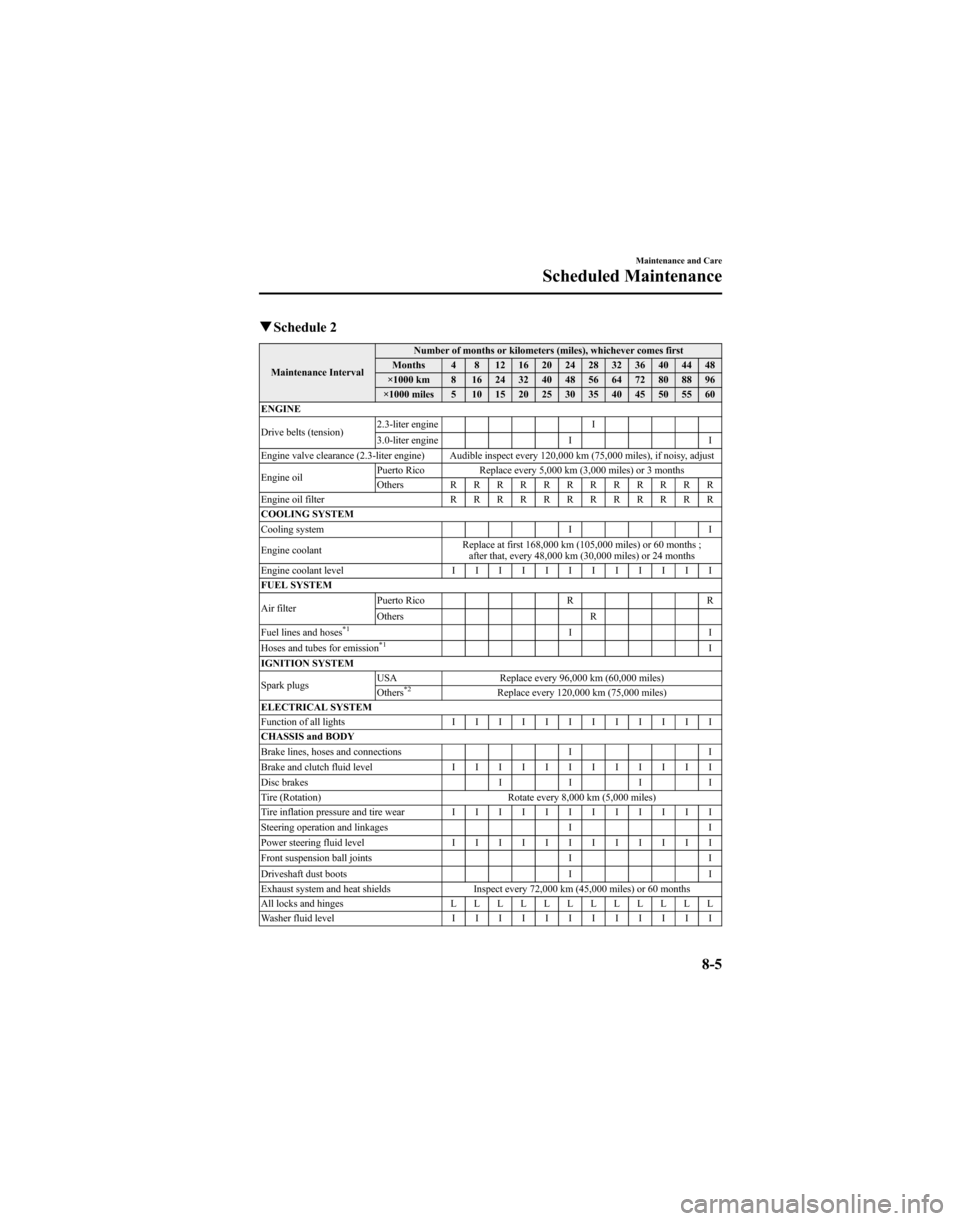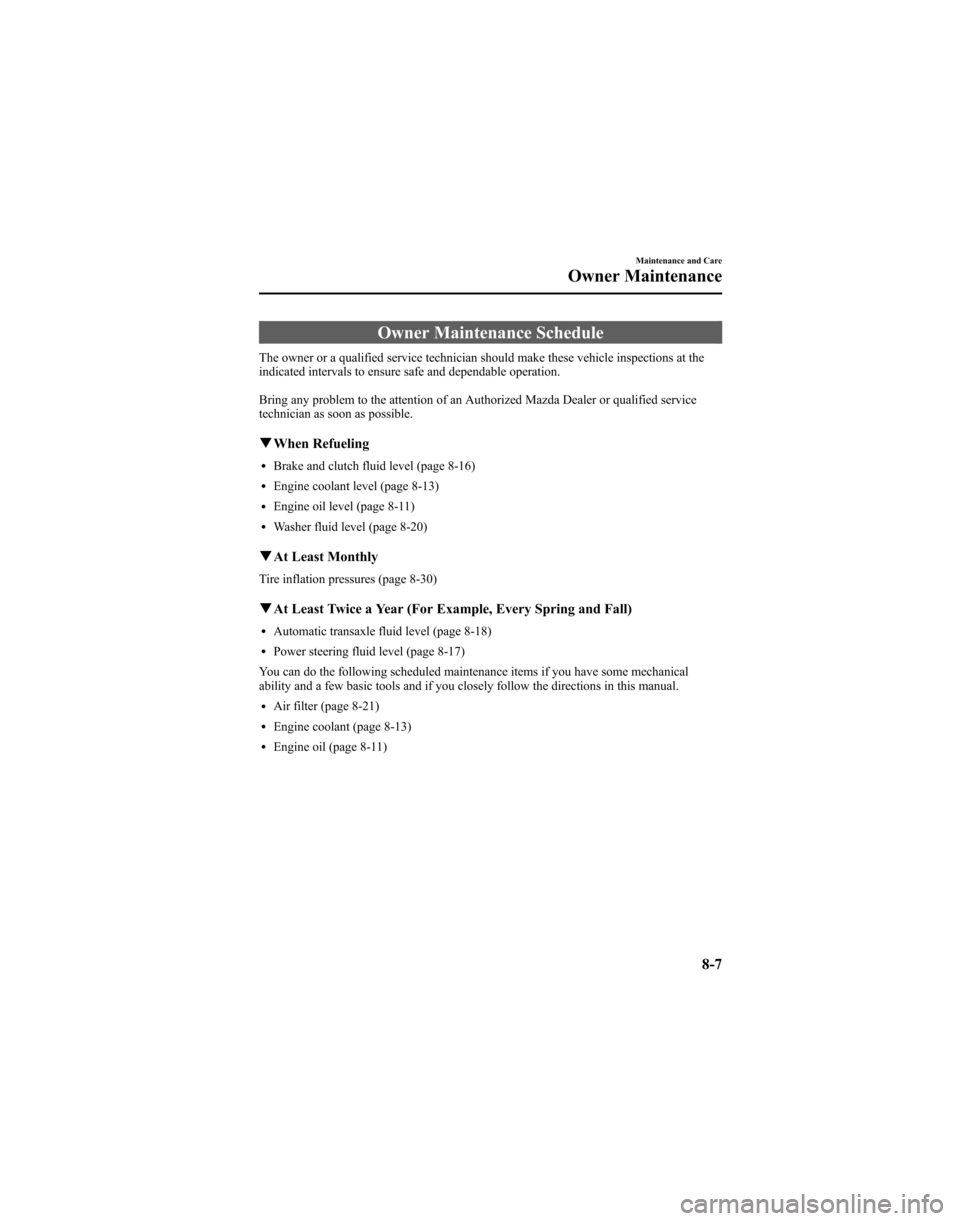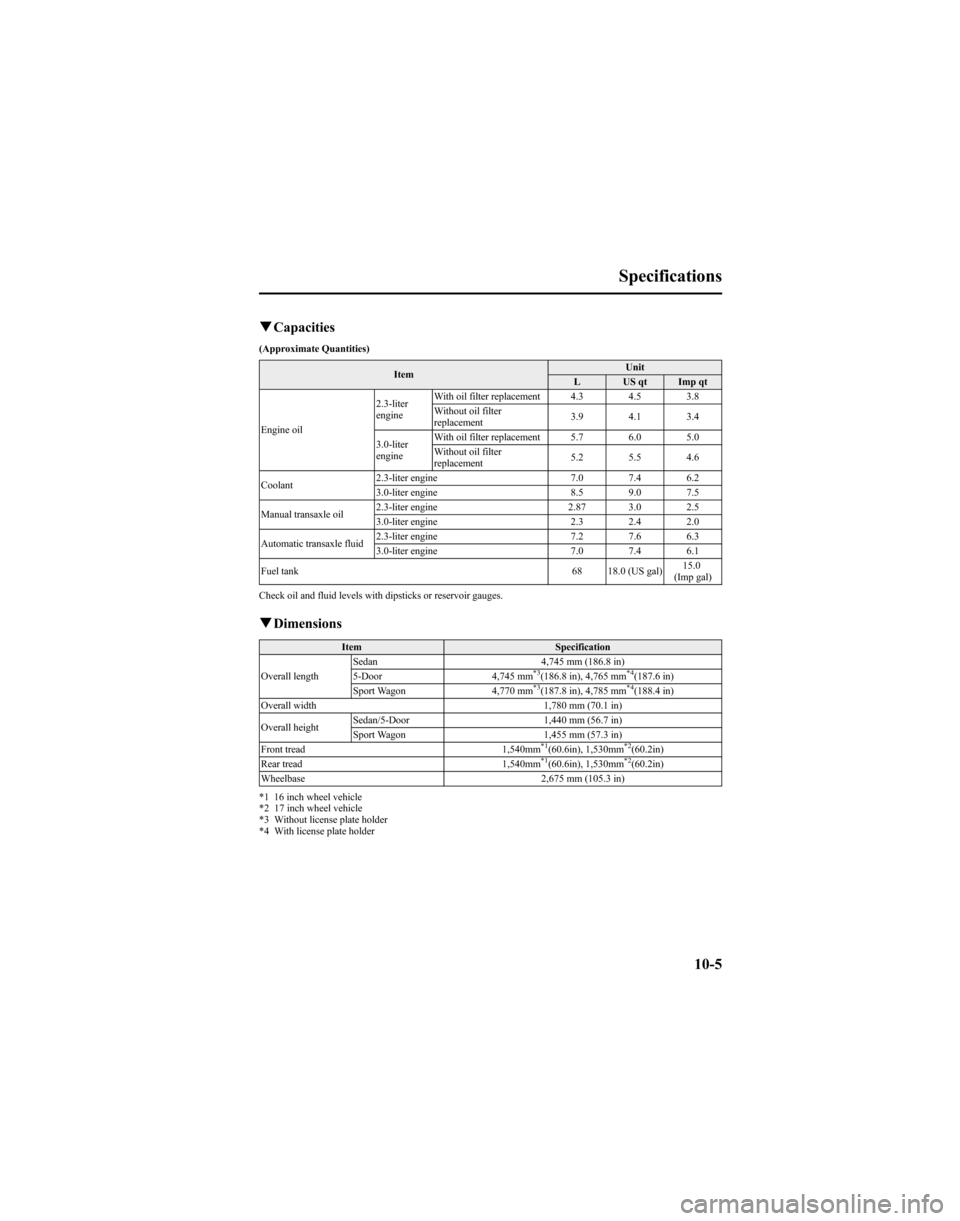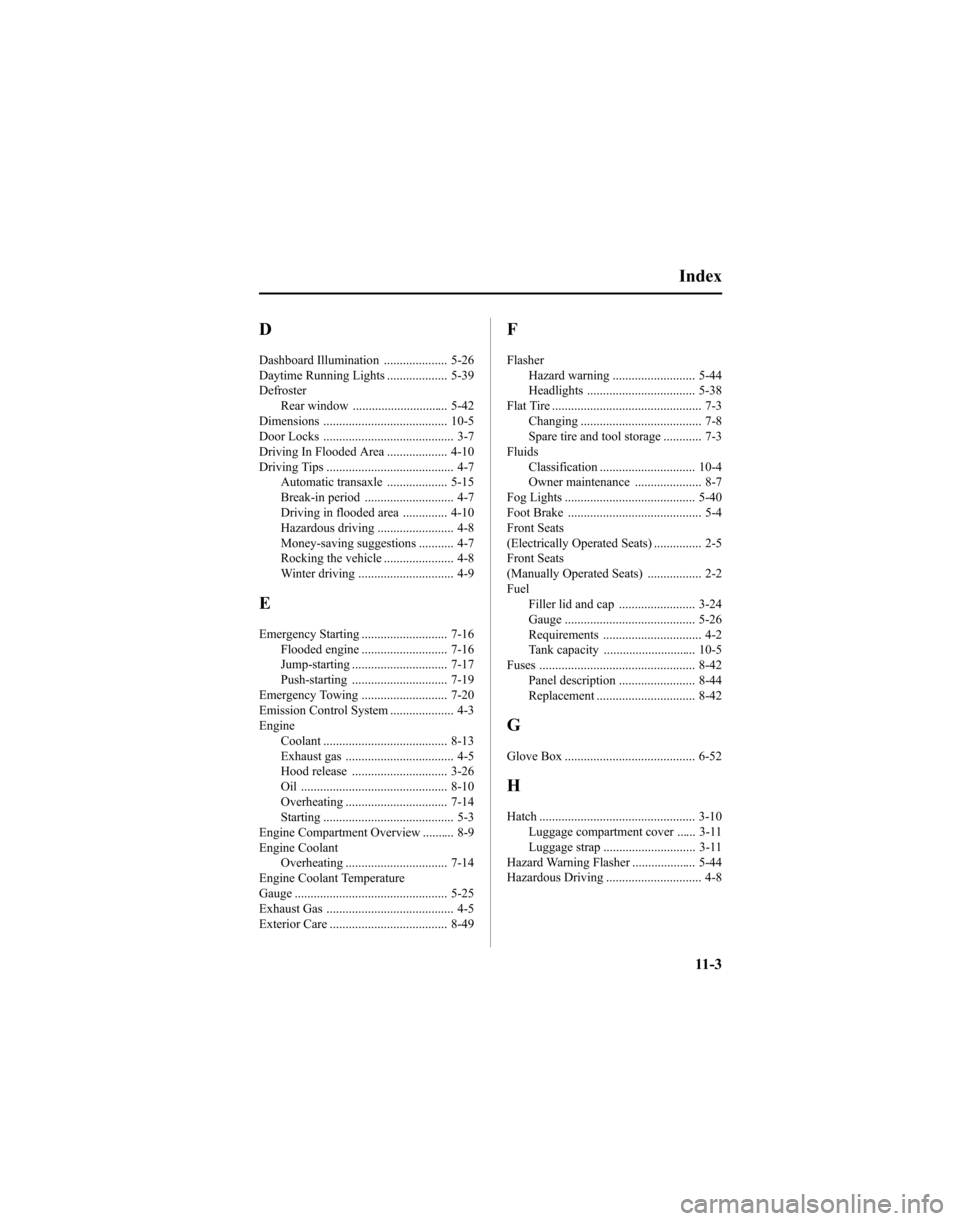engine coolant MAZDA MODEL 6 HATCHBACK 2005 (in English) User Guide
[x] Cancel search | Manufacturer: MAZDA, Model Year: 2005, Model line: MODEL 6 HATCHBACK, Model: MAZDA MODEL 6 HATCHBACK 2005Pages: 340, PDF Size: 3.08 MB
Page 255 of 340

qSchedule 2
Maintenance Interval Number of months or kilometers (miles), whichever comes first
Months 4 8 12 16 20 24 28 32 36 40 44 48
×1000 km 8 16 24 32 40 48 56 64 72 80 88 96
×1000 miles 5 10 15 20 25 30 35 40 45 50 55 60
ENGINE
Drive belts (tension) 2.3-liter engine I
3.0-liter engine I I
Engine valve clearance (2.3-liter engine) Audible inspect every 120,000 km (75,000 miles), if noisy, adjust
Engine oil Puerto Rico Replace every 5,000 km (3,000 miles) or 3 months
Others R R R R R R R
RRRRR
Engine oil filter R R R R R R R RRRRR
COOLING SYSTEM
Cooling system I I
Engine coolant Replace at first 168,000 km (105,000 miles) or 60 months ;
after that, every 48,000 km (30,000 miles) or 24 months
Engine coolant level I I I I I I I IIIII
FUEL SYSTEM
Air filter Puerto Rico R R
Others R
Fuel lines and hoses
*1II
Hoses and tubes for emission*1I
IGNITION SYSTEM
Spark plugs USA Replace every 96,000 km (60,000 miles)
Others
*2Replace every 120,000 km (75,000 miles)
ELECTRICAL SYSTEM
Function of all lights I I I I I I I IIIII
CHASSIS and BODY
Brake lines, hoses and connections I I
Brake and clutch fluid level I I I I I I I IIIII
Disc brakes IIII
Tire (Rotation) Rotate every 8,000 km (5,000 miles)
Tire inflation pressure and tire wear I I I I I I I IIIII
Steering operation and linkages I I
Power steering fluid level I I I I I I I IIIII
Front suspension ball joints I I
Driveshaft dust boots I I
Exhaust system and heat shields Inspect every 72,000 km (45,000 miles) or 60 months
All locks and hinges L L L L L L LLLLLL
Washer fluid level I I I I I I I IIIII
Maintenance and Care
Scheduled Maintenance
8-5
Page 257 of 340

Owner Maintenance Schedule
The owner or a qualified service technician should make these vehicle inspections at the
indicated intervals to ensure safe and dependable operation.
Bring any problem to the attention of an Authorized Mazda Dealer or qualified service
technician as soon as possible.
qWhen Refueling
lBrake and clutch fluid level (page 8-16)
lEngine coolant level (page 8-13)
lEngine oil level (page 8-11)
lWasher fluid level (page 8-20)
qAt Least Monthly
Tire inflation pressures (page 8-30)
qAt Least Twice a Year (For Example, Every Spring and Fall)
lAutomatic transaxle fluid level (page 8-18)
lPower steering fluid level (page 8-17)
You can do the following scheduled maintenance items if you have some mechanical
ability and a few basic tools and if you closely follow the directions in this manual.
lAir filter (page 8-21)
lEngine coolant (page 8-13)
lEngine oil (page 8-11)
Maintenance and Care
Owner Maintenance
8-7
Page 259 of 340

Engine Compartment Overview
Power steering
fluid reservoirWindshield washer
fluid reservoir
Fuse block
Air filter
Brake/Clutch fluid reservoir
Engine coolant
reservoir
Engine coolant
reservoir Automatic transaxle fluid-level dipstick
(only for automatic transaxle) Automatic transaxle fluid-level dipstick
(only for automatic transaxle)
2.3-liter engine
3.0-liter engine Battery
Engine oil dipstick
Windshield washer
fluid reservoir Power steering
fluid reservoir
Cooling system cap Engine oil-filler cap
Brake/Clutch fluid reservoir
Air filter Fuse blockBattery
Engine oil-filler cap
Engine oil dipstick Cooling system cap
Maintenance and Care
Owner Maintenance
8-9
Page 263 of 340

Oil capacity (General reference only,
refer to Specifications section for
capacities.)
NOTE
lThe indicated engine oil capacities
are for general reference purposes
only. When adding or changing oil,
verify the engine oil level with the
oil dipstick.
lUse only specified engine oil (page
10-4).
Changing oil filter
Because you need a special tool to
retighten the filter, an Authorized Mazda
Dealer should do the work.
Engine Coolant
qInspecting Coolant Level
WARNING
Hot Engine:
A hot engine is dangerous. If the
engine has been running, parts of the
engine compartment can become very
hot. You could be burned. Carefully
inspect the engine coolant in the
coolant reservoir, but do not open it.
Do not use a match or live flame in the
engine compartment. DO NOT ADD
COOLANT WHEN THE ENGINE IS
HOT.
Cooling Fan and EngineInspection:
Inspecting the engine with the ignition
switch in the ON position is
dangerous. The cooling fan could turn
on unexpectedly even when the engine
isn't running. You could be seriously
injured by the fan. Turn the ignition
switch off and remove the key from the
ignition switch when you inspect the
engine.
Cooling System Cap:
When the engine and radiator are hot,
scalding coolant and steam may shoot
out under pressure and cause serious
injury. Don't remove the cooling
system cap when the engine and
radiator are hot.
Maintenance and Care
Owner Maintenance
8-13
Page 264 of 340

Inspect the antifreeze protection and
coolant level in the coolant reservoir at
least once a year―at the beginning of the
winter season ―and before traveling
where temperatures may drop below
freezing.
Inspect the condition and connections of
all cooling system and heater hoses.
Replace any that are swollen or
deteriorated.
The coolant should be at full in the
radiator and between the FULL or F and
LOW or L marks on the coolant reservoir
when the engine is cool.
2.3-liter engine
3.0-liter engine
If it's at or near LOW or L, add enough
coolant to the coolant reservoir to provide
freezing and corrosion protection and to
bring the level to FULL or F.
CAUTION
Radiator coolant will damage paint.
Rinse it off quickly if spilled.
If the coolant reservoir is empty or new
coolant is required frequently, consult an
Authorized Mazda Dealer.
q Changing Coolant
Change coolant according to Scheduled
Maintenance (page 8-3).
CAUTION
lUse only soft (demineralized) water
in the coolant mixture. Water that
contains minerals will cut down on
the coolant's effectiveness.
lDon't add only water. Always add a
proper coolant mixture.
lThe engine has aluminum parts and
must be protected by an ethylene-
glycol-based coolant to prevent
corrosion and freezing.
lDO NOT USE coolants Containing
Alcohol, methanol, Borate or
Silicate.
These coolants could damage the
cooling system.
lDO NOT MIX alcohol or methanol
with the coolant. This could damage
the cooling system.
lDon't use a solution that contains
more than 60 % antifreeze.
This would reduce effectiveness.
8-14
Maintenance and Care
Owner Maintenance
Page 265 of 340

For mixture percentage:
ProtectionVolume
Antifreeze solutionDemineralizedwater
Above –16°C (3°F) 35% 65%
Above –26°C ( –15°F) 45% 55%
Above –40°C ( –40°F) 55% 45%
To change coolant
WARNING
Removing the Cooling System Cap:
Removing the cooling system cap
while the engine is running or hot is
dangerous. This might lead to cooling
system and engine damage and could
result in serious injury from escaping
hot coolant or steam. Turn off the
engine and wait until it's cool. Even
then, be very careful when removing
the cap.
Wrap a thick cloth around the cap and
slowly turn it counterclockwise to the
first stop (3.0-liter engine) or about
two and a half rotations (2.3-liter
engine).
Step back while the pressure escapes.
When you're sure all the pressure is
gone, press down on the cap (3.0-liter
engine) ―still using a cloth ―turn
the cap, and remove it. 1. Remove the cooling system cap.
2.3-liter engine
Loosen
Tighten
Loosen
Tighten
3.0-liter engine Loosen
TightenTighten Loosen
2. Only when the engine is cool, remove
the radiator drain plug and drain the
coolant into a suitable container.
Properly dispose of the used coolant.
3. Flush out the system with running water.
4. Drain the system completely. Insert and tighten the plug. Add as much
ethylene-glycol-based coolant mixture
and water as necessary to provide
freezing and corrosion protection.
5. In extremely cold climates, add the mixture percentage recommended in
the coolant mixture percentage table.
Maintenance and Care
Owner Maintenance
8-15
Page 266 of 340

6. Run the engine at idle with the coolingsystem cap off. Slowly add additional
coolant if necessary.
7. At this point, wait until the engine reaches normal operating temperature;
then depress the accelerator two or
three times. Add more coolant, if
necessary, until the system is full.
8. Install the cooling system cap. Inspect all connections for leaks. Inspect the
level in the coolant reservoir one more
time.Brake/Clutch Fluid
qInspecting Brake/Clutch Fluid
Level
The brakes and clutch draw fluid from the
same reservoir.
Inspect the fluid level in the reservoir
regularly. It should be kept at MAX.
The level normally drops with
accumulated distance, a condition
associated with wear of brake and clutch
linings. If it is excessively low, have the
brake/clutch system inspected by an
Authorized Mazda Dealer.
8-16
Maintenance and Care
Owner Maintenance
Page 329 of 340

qCapacities
(Approximate Quantities)
Item Unit
L US qt Imp qt
Engine oil 2.3-liter
engine
With oil filter replacement 4.3 4.5 3.8
Without oil filter
replacement
3.9 4.1 3.4
3.0-liter
engine With oil filter replacement 5.7 6.0 5.0
Without oil filter
replacement
5.2 5.5 4.6
Coolant 2.3-liter engine 7.0 7.4 6.2
3.0-liter engine 8.5 9.0 7.5
Manual transaxle oil 2.3-liter engine 2.87 3.0 2.5
3.0-liter engine 2.3 2.4 2.0
Automatic transaxle fluid 2.3-liter engine 7.2 7.6 6.3
3.0-liter engine 7.0 7.4 6.1
Fuel tank 68 18.0 (US gal) 15.0
(Imp gal)
Check oil and fluid levels with dipsticks or reservoir gauges.
q Dimensions
Item Specification
Overall length Sedan 4,745 mm (186.8 in)
5-Door 4,745 mm
*3(186.8 in), 4,765 mm*4(187.6 in)
Sport Wagon 4,770 mm*3(187.8 in), 4,785 mm*4(188.4 in)
Overall width 1,780 mm (70.1 in)
Overall height Sedan/5-Door 1,440 mm (56.7 in)
Sport Wagon 1,455 mm (57.3 in)
Front tread 1,540mm
*1(60.6in), 1,530mm*2(60.2in)
Rear tread 1,540mm*1(60.6in), 1,530mm*2(60.2in)
Wheelbase 2,675 mm (105.3 in)
*1 16 inch wheel vehicle
*2 17 inch wheel vehicle
*3 Without license plate holder
*4 With license plate holder
Specifications
10-5
Page 335 of 340

D
Dashboard Illumination .................... 5-26
Daytime Running Lights ................... 5-39
DefrosterRear window .............................. 5-42
Dimensions ....................................... 10-5
Door Locks ......................................... 3-7
Driving In Flooded Area ................... 4-10
Driving Tips ........................................ 4-7 Automatic transaxle ................... 5-15
Break-in period ............................ 4-7
Driving in flooded area .............. 4-10
Hazardous driving ........................ 4-8
Money-saving suggestions ........... 4-7
Rocking the vehicle ...................... 4-8
Winter driving .............................. 4-9
E
Emergency Starting ........................... 7-16Flooded engine ........................... 7-16
Jump-starting .............................. 7-17
Push-starting .............................. 7-19
Emergency Towing ........................... 7-20
Emission Control System .................... 4-3
Engine Coolant ....................................... 8-13
Exhaust gas .................................. 4-5
Hood release .............................. 3-26
Oil .............................................. 8-10
Overheating ................................ 7-14
Starting ......................................... 5-3
Engine Compartment Overview .......... 8-9
Engine Coolant Overheating ................................ 7-14
Engine Coolant Temperature
Gauge ................................................ 5-25
Exhaust Gas ........................................ 4-5
Exterior Care ..................................... 8-49
F
Flasher Hazard warning .......................... 5-44
Headlights .................................. 5-38
Flat Tire ............................................... 7-3
Changing ...................................... 7-8
Spare tire and tool storage ............ 7-3
Fluids
Classification .............................. 10-4
Owner maintenance ..................... 8-7
Fog Lights ......................................... 5-40
Foot Brake .......................................... 5-4
Front Seats
(Electrically Operated Seats) ............... 2-5
Front Seats
(Manually Operated Seats) ................. 2-2
Fuel
Filler lid and cap ........................ 3-24
Gauge ......................................... 5-26
Requirements ............................... 4-2
Tank capacity ............................. 10-5
Fuses ................................................. 8-42 Panel description ........................ 8-44
Replacement ............................... 8-42
G
Glove Box ......................................... 6-52
H
Hatch ................................................. 3-10Luggage compartment cover ...... 3-11
Luggage strap ............................. 3-11
Hazard Warning Flasher .................... 5-44
Hazardous Driving .............................. 4-8
Index
11-3